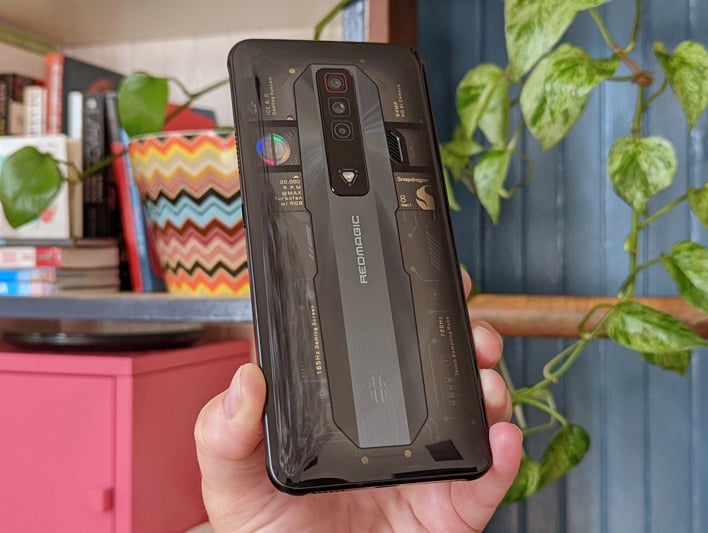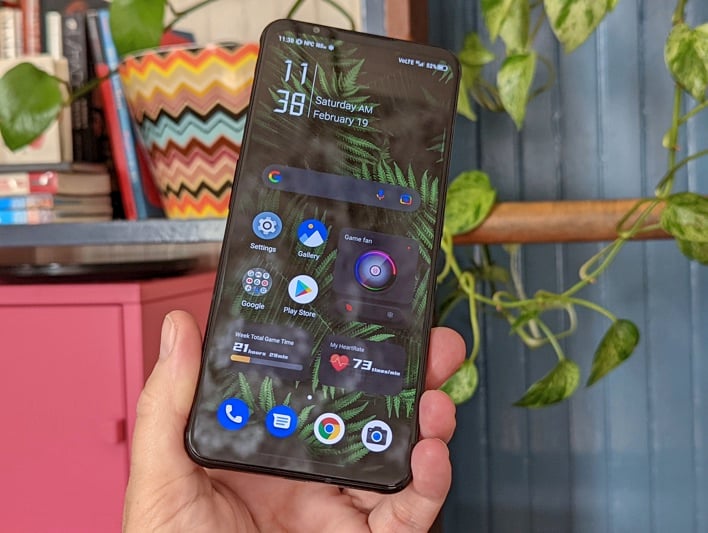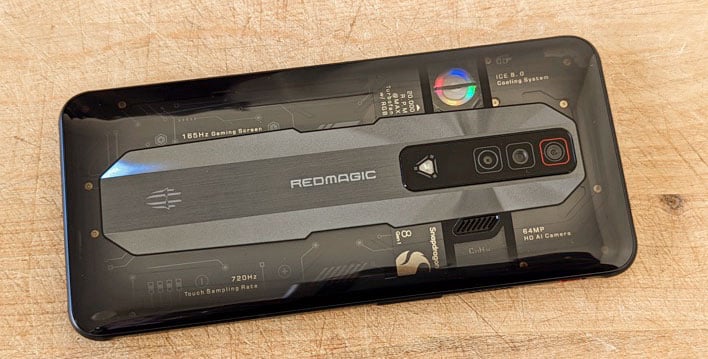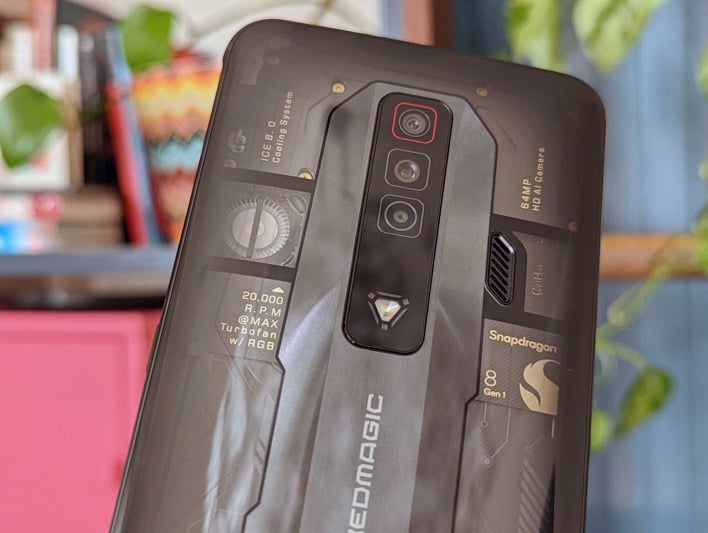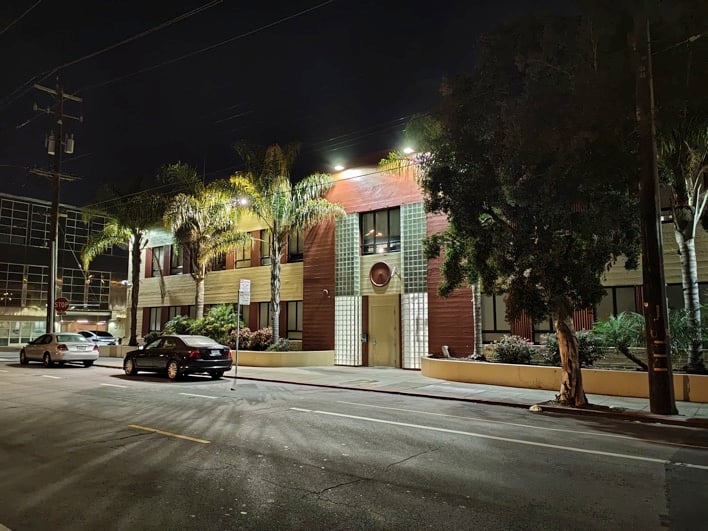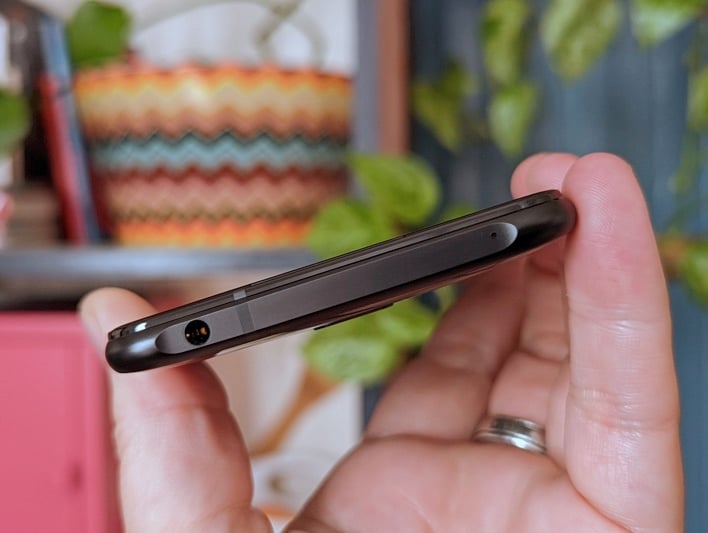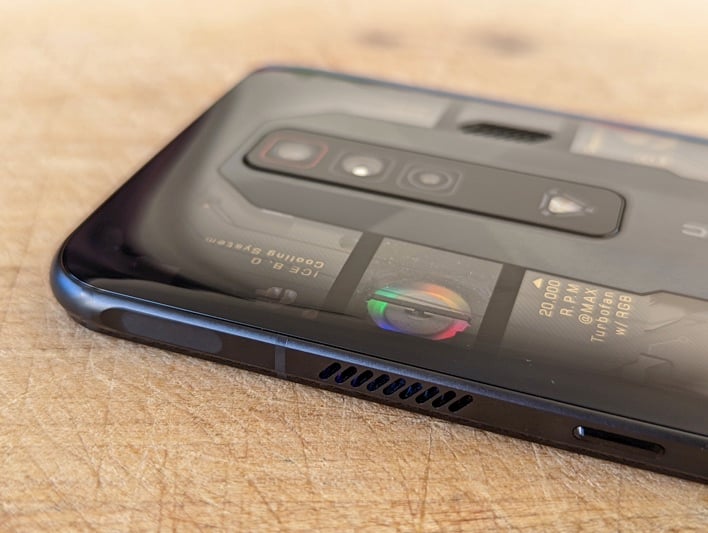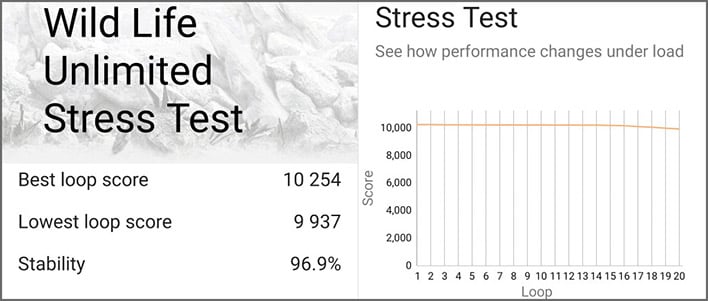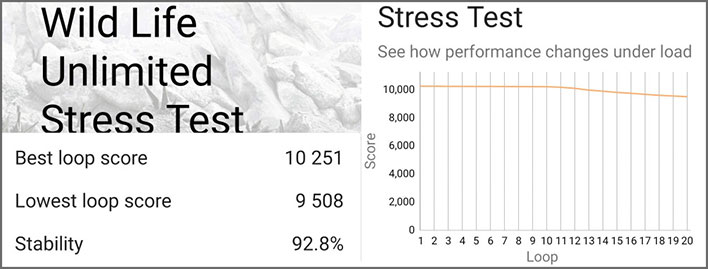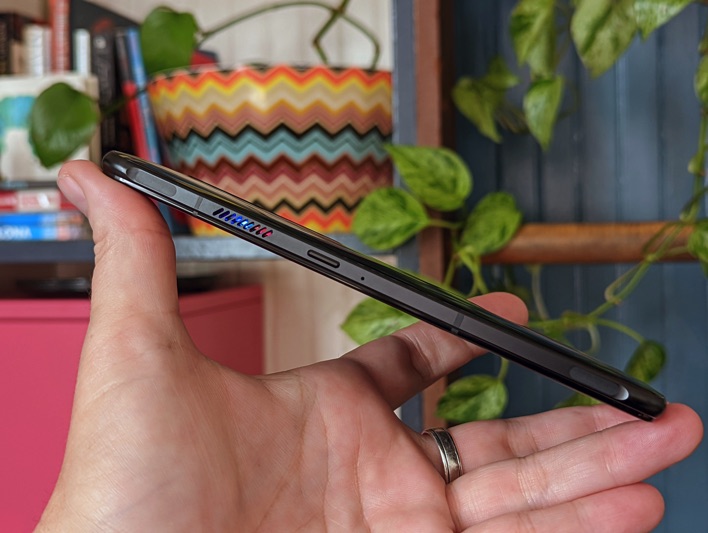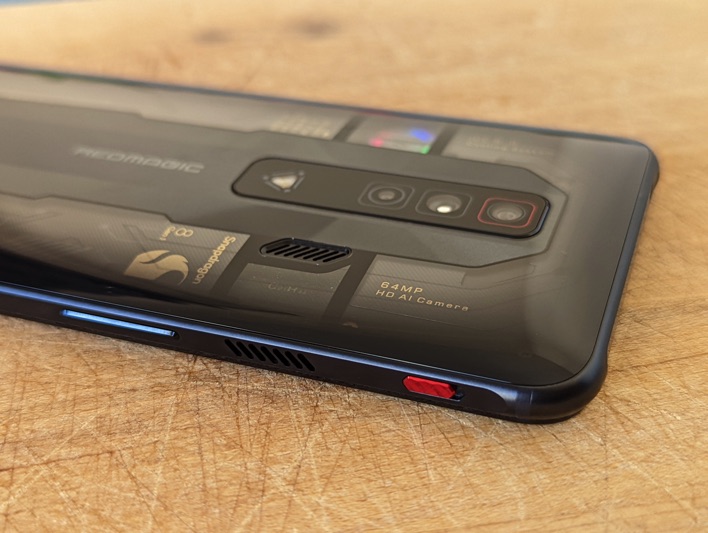RedMagic 7 Review: A Crazy-Fast, Affordable Snapdragon Gaming Phone
RedMagic 7 Review: Snapdragon 8 Gen 1 Gaming Champ
Over the years, Chinese phone manufacturer
RedMagic has managed to build a reputation for making affordable,
feature-packed gaming phones and selling them in the US. The company
typically releases new models in the spring using Qualcomm’s latest
flagship processor, then launches similar, but updated versions in the
fall, often with Qualcomm’s revised “plus” chipsets. And since the RedMagic 3,
these handsets have included a built-in cooling fan to maintain optimal, sustained performance.
With last year’s RedMagic 6, the company also introduced Pro variants with slightly improved specs to its lineup, alongside a fan-less, more mainstream handset – the RedMagic 6R. Today we’re testing the Snapdragon 8 Gen 1-equipped RedMagic 7 ($629), which shares its overall design, 165Hz display, and 64MP triple camera system with its predecessor. So, is RedMagic still the gaming phone value champ? Let’s find out...
With last year’s RedMagic 6, the company also introduced Pro variants with slightly improved specs to its lineup, alongside a fan-less, more mainstream handset – the RedMagic 6R. Today we’re testing the Snapdragon 8 Gen 1-equipped RedMagic 7 ($629), which shares its overall design, 165Hz display, and 64MP triple camera system with its predecessor. So, is RedMagic still the gaming phone value champ? Let’s find out...
RedMagic 7 Hardware And Design
Like most gaming laptops, most gaming phones have a distinctly loud
“made-for-gamers” aesthetic, and the RedMagic 7 is no exception. But
instead of being mostly black with colored stripes and accents (or red
like some past RedMagic handsets), our review unit’s glass back is made of
a transparent and metallic gray finish the company calls Supernova. The
transparent areas reveal the cooling fan, screws, and other parts.
If you look closely, though, those parts are just covers under the glass, not the actual components. These covers have fake circuit board traces on them. Still, it’s pretty cool – if you’re into over-the-top gamer designs. And of course, the fan is backlit with green, yellow, red, and blue LEDs (the Google colors, incidentally) arranged in a circle. Even the RedMagic logo lights up in red (naturally) with a programmable LED.
If you look closely, though, those parts are just covers under the glass, not the actual components. These covers have fake circuit board traces on them. Still, it’s pretty cool – if you’re into over-the-top gamer designs. And of course, the fan is backlit with green, yellow, red, and blue LEDs (the Google colors, incidentally) arranged in a circle. Even the RedMagic logo lights up in red (naturally) with a programmable LED.
But fear not, all those blinkenlights can be disabled if you wish. A bunch of specs are stenciled in gold all over the rear glass, including “165Hz Gaming Screen”, “20,000 R. P. M. @ MAX Turbofan w/ RGB”, “ICE 8. 0 Cooling System”, “64MP AI HD Camera”, “720Hz Touch Sampling Rate”, and a fake Snapdragon 8 Gen 1 chip. Yeah, it’s quite something. It makes the vertical rectangular camera pod down the middle look downright boring.
Other colors include Obsidian (black) and Pulsar (pink and blue), which both lose the semi-transparent back, but gain RGB lights. In front, the 6.8-inch display is free of punch holes or notches, but includes small top and bottom bezels for the 8MP selfie shooter and the earpiece / speaker. As a result, the RedMagic 7 is a big phone – larger even than Samsung’s massive Galaxy S22 Ultra. Still, it feels very nice in hand.
RedMagic’s done a great job blending the rear glass into the aluminum frame. The right side is home to the two capacitive shoulder buttons, fan exhaust, power / lock key, and a third mic. On the left side, you’ll find the red game mode switch, fan intake, and volume rocker. The main speaker, USB Type-C port (USB 3.0), primary mic, and SIM tray are located along the bottom, and the headphone jack and secondary mic live on top.
Obviously, with all those fan openings (there’s even a third one in the glass back), the RedMagic 7 isn’t water or dust resistant. Build quality and materials are top notch, however, and this handset simply feels solid and well-built.
Here's our RedMagic 7 unboxing video before we look at the specs...
RedMagic 7 Specs And Features
| Processing and 5G Platform | Qualcomm
Snapdragon 8 Gen 1 + integrated Snapdragon X65 5G Modem |
| Display | 6.8" FHD+ (20:9) AMOLED, 2400x1080 resolution, 165Hz |
| Memory | 12/16/18GB
LPDDR5 |
| Storage | 128/256GB
UFS 3.1, no microSD |
| Rear-Facing Cameras | 64MP f/1.8 Main
PDAF - 8MP f/2.0 120º Ultra-Wide - 2MP f/2.4 Macro |
| Front-Facing Cameras | 8MP f/2.0 |
| Video Recording | Up to 8K @ 30fps, 4K @ 60fps, 1080p @ 60fps, 1080p slow-mo |
| Battery | 4500
mAh, 65W wired charging, no wireless charging |
| OS | Android 12 With
RedMagic OS 5.0 |
| Dimensions | 170.6 x 78.3 x 9.5mm |
| Weight | 215 grams |
| Connectivity | 802.11ax
Wi-Fi 6E, Bluetooth 5.2+LE, NFC, USB-C, LTE, 5G |
| Colors | Obsidian,
Pulsar, Supernova |
| Pricing | Find the RedMagic 7 @ Amazon, Starting at $629 |
RedMagic 7 Display Quality
Gaming requires a quality display, and the RedMagic 7 delivers. It
packs a beautiful 6.8-inch FHD+ (2400 x 1080 pixels, 387ppi) 10-bit AMOLED
panel with a 20:9 aspect ratio and a speedy 165Hz refresh rate. This
screen is also perfectly flat and unfettered by notches or punch holes.
Besides the ultra-smooth 165Hz refresh rate (plus settings for 120, 90,
and 60 Hz), the RedMagic 7 also boasts a 720Hz touch sampling rate.
Like other modern AMOLED panels, this display offers punchy colors,
inky blacks, and wide viewing angles. At 770 nits (typical), it’s also
easy to read in direct sunlight – even though it’s not nearly as bright as
today’s best screens. But overall, we have no complaints here.
RedMagic 7 Camera Performance And Image Quality
Imaging hasn't historically been RedMagic’s forte, and things are no different with the
RedMagic 7. Not much has changed with this camera system since the
RedMagic 5G we reviewed almost two years ago. You’re basically getting
slightly worse hardware but marginally better software. This consists of a
64MP f/1.8 0.7-micron main shooter (without OIS), an 8MP f/2.0 1.12-micron
120-degree ultrawide, and a 2MP f/2.4 macro (without AF).
For selfies, you’ll find an 8MP f/2.0 1.12-micron camera above the display. So what’s actually changed with the hardware? It appears that RedMagic has replaced Sony’s excellent 64MP IMX 686 with another, lesser 64MP sensor, dropping the pixel size from 0.8 to 0.7 microns. While this isn’t a deal breaker, it means we can expect reduced low light and zoom performance, both of which are already hindered by the lack of OIS.
On the software front, the camera app is still somewhat disorganized, but RedMagic’s finally made the ultrawide shooter available outside of pro mode. Also, the former DNG mode (for shooting RAW images) has been rolled into pro mode. Shooting modes include portrait, night, pro, pro video, panorama, macro, time lapse (1080p 30fps), and slow motion (1080p 120/240/480/960fps) – to name the important ones.
Sadly, night mode is still not supported by the ultrawide and selfie
cameras. Video recording maxes out at 8k 30fps (unstabilized), and 4k
60fps (stabilized) with the main shooter, plus 1080p 30fps (unstabilized)
with the selfie camera. HDR video recording is available at up to 4k
(30fps, unstabilized). But the RedMagic 7 still only captures audio in
mono, just like the RedMagic 5G. That’s just unacceptable at $629.
Pictures taken with the RedMagic 7 are decent overall, especially in
daylight, but image quality degrades in low light or when zooming
past 3-4x. Night mode really helps here, but only on the main shooter. The
macro‘s low resolution and lack of AF makes for lackluster results.
Selfies are fine, but not spectacular – ditto for video recording. Ultimately,
there are handsets that cost half the price with better camera systems. RedMagic clearly focuses on gaming first with this device, and imaging – while passable – is secondary.
RedMagic 7 Audio, Data, And Call Reception
We used the RedMagic 7 mostly on T-Mobile’s sub-6GHz 5G network in San
Francisco and the Bay Area and didn’t run into any issues with reception,
call quality, and data speeds. This phone also works on AT&T’s
sub-6GHz 5G network and Verizon’s 4G LTE network. It’s unclear if it also
supports Verizon's sub-6GHz 5G network (we’ve reached out to RedMagic for
clarification). As you’d expect, the RedMagic 7 lacks mmWave 5G.
The RedMagic 7 features stereo speakers (earpiece plus bottom edge speaker) which sound loud and clear at low to mid volumes, but muddier at higher volumes. While no match for today’s best flagship speakers, these will satisfy most users. As a bonus, the RedMagic 7 includes a headphone jack driven by an excellent DAC and amp. There’s also aptX HD and LDAC support for high quality wireless audio over Bluetooth.
RedMagic 7 Performance And Battery Life
As we previously mentioned, the RedMagic 7
uses Qualcomm’s flagship 4nm Snapdragon 8 Gen 1 chip, but that’s only half
the story. Our $799 Supernova review unit boasts a whopping 18GB of LPDDR5
RAM and 256GB of UFS 3.1 storage, while the $729 Pulsar and $629 Obsidian
models come with 16/256GB and 12/128GB of RAM/storage, respectively.
There’s no microSD support here, so choose your configuration wisely.
Day-to-day, the RedMagic 7 is lightning fast no matter what you’re doing. It ran everything we threw at it without skipping a beat – from our standard productivity apps to graphically demanding games like Genshin Impact and Real Racing 3. Ultimately though, the RedMagic 7 didn’t feel quicker or smoother than the Snapdragon 8 Gen 1-equipped Samsung Galaxy S22 Ultra and S22+ we just reviewed.
Subjective performance is one thing, but our benchmarks tell a different story. The RedMagic 7 beat Samsung’s flagships in several of our tests, showing significant gains with GPU workloads. More importantly, the RedMagic 7 didn’t exhibit any of the heavy throttling we experienced with the Galaxy S22 Ultra and S22+ – whether we enabled the 20,000 rpm fan or not, and regardless of the refresh rate.
RedMagic 7 Geekbench Results
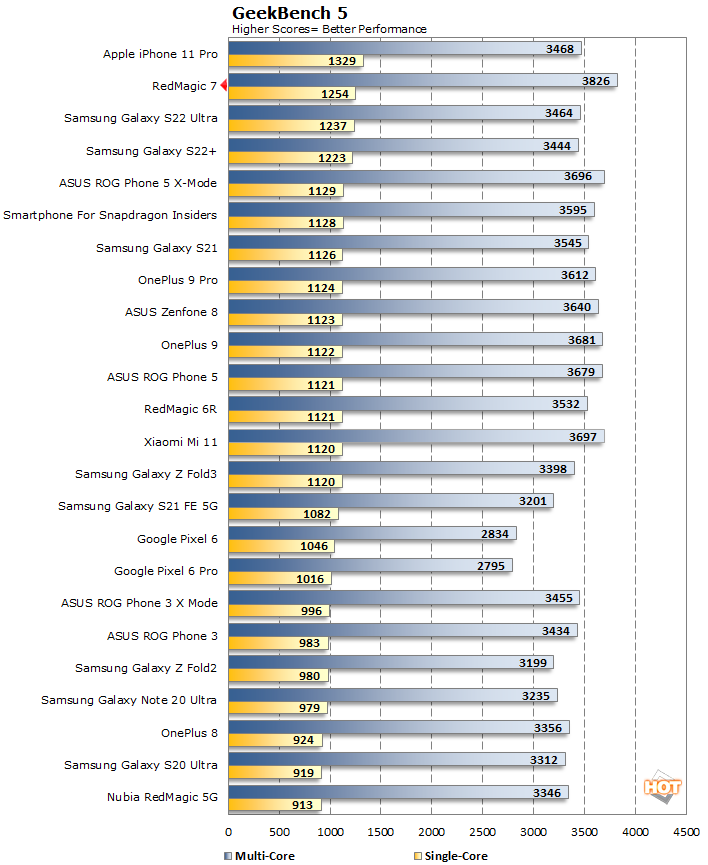
GeekBench isn't our favorite benchmark, as
it's purely synthetic and can be heavily targeted for optimization.
Regardless, the Snapdragon 8 Gen 1 processor delivers a slight
improvement in single thread performance but marginal improvement
in multi-threaded performance over previous generation Snapdragon 888-equipped Android flagships.
RedMagic 7 PCMark For Android Benchmarks
Futuremark's PCMark for Android is an
excellent suite of tests if you want to benchmark a wide range of tasks
on any handset -- things like image and video editing, as well as
lighter-duty, everyday workloads such as email and web browsing. When
you see the test running live, it's clear the scripted application tests
are carefully selected and tuned to make use of the each mobile platform
in a very controlled way...
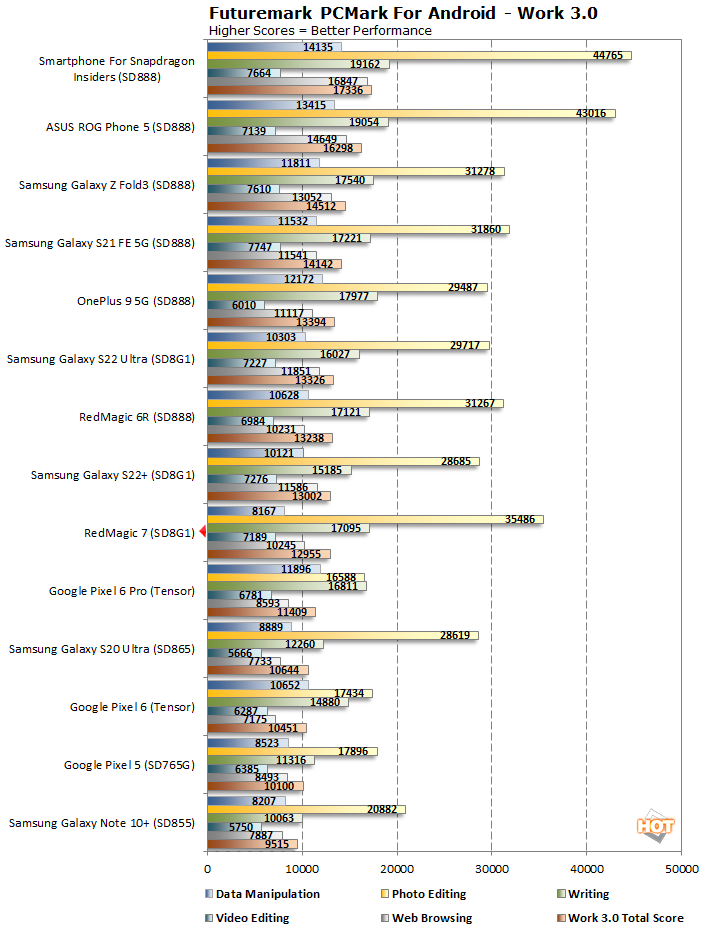
Here the RedMagic 7 shows similar performance to previous generation
flagships, falling just behind Samsung's Galaxy S22+.
RedMagic 7 AnTuTu 8 Benchmark Results
AnTuTu’s latest benchmark returns a number
of metrics ranked with somewhat nebulous scores, rather than frame rates
or time to complete. Here we're running the latest version of AnTuTu
across multiple Android devices. AnTuTu returns four top level
performance results which are all included here: CPU, RAM, 3D, UX (or
User Experience), along with a total score...

According to AnTuTu, The RedMagic 7 offers
a substantial increase in performance vs. previous generation Android
handsets, with the RedMagic 7 beating Samsung's recent Galaxy S22 Ultra
in overall score and finishing at the top of charts.

However, in AITuTu, which is specifically an image recognition and classification benchmark for AI and machine learning workloads, we see a different picture. Here there are big gains for the Snapdragon 8 Gen 1 powered RedMagic 7, but it doesn't catch two scores in our database from Snapdragon 888-powered devices. We've found this to be the case where some phones might not have the latest neural network models installed in the phone's firmware packages, so an update here from RedMagic could easily change this picture.
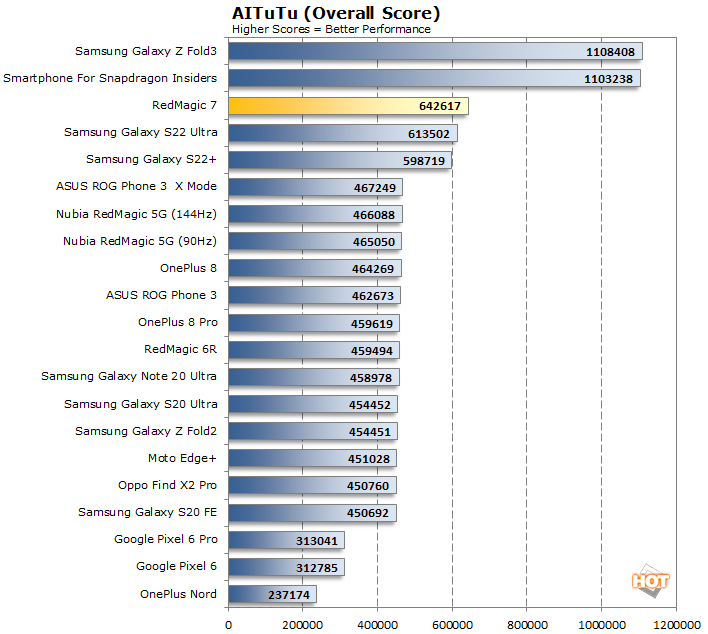
However, in AITuTu, which is specifically an image recognition and classification benchmark for AI and machine learning workloads, we see a different picture. Here there are big gains for the Snapdragon 8 Gen 1 powered RedMagic 7, but it doesn't catch two scores in our database from Snapdragon 888-powered devices. We've found this to be the case where some phones might not have the latest neural network models installed in the phone's firmware packages, so an update here from RedMagic could easily change this picture.
3D Graphics And Gaming Benchmarks With The RedMagic 7
Next we're checking how the RedMagic 7
compares in GFXBench, which has been one of the standard mobile
graphics/gaming performance benchmarks for years. To ensure that display
refresh (v-sync) and resolution aren't limiting factors, we're comparing
off-screen test results here. GFXBench tests OpenGL ES graphics
workloads and we're specifically testing OpenGL ES 2.0 and 3.0.
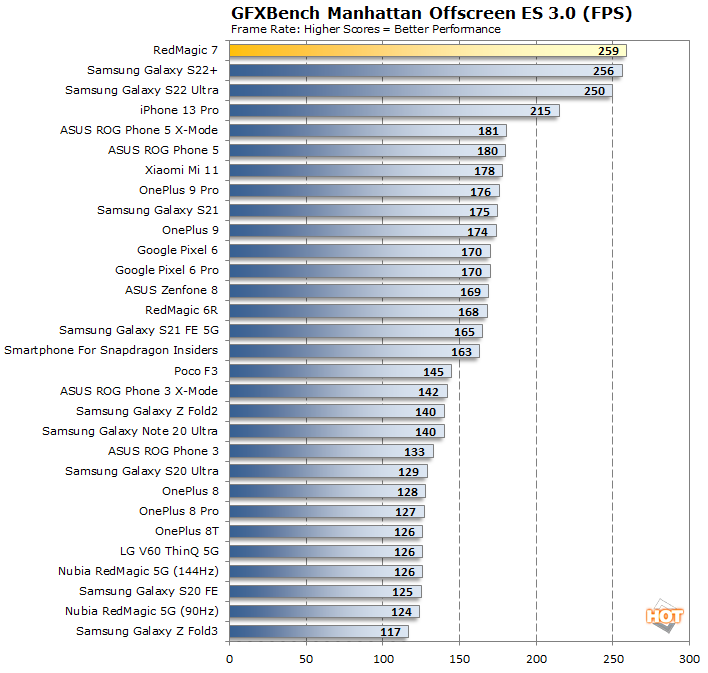
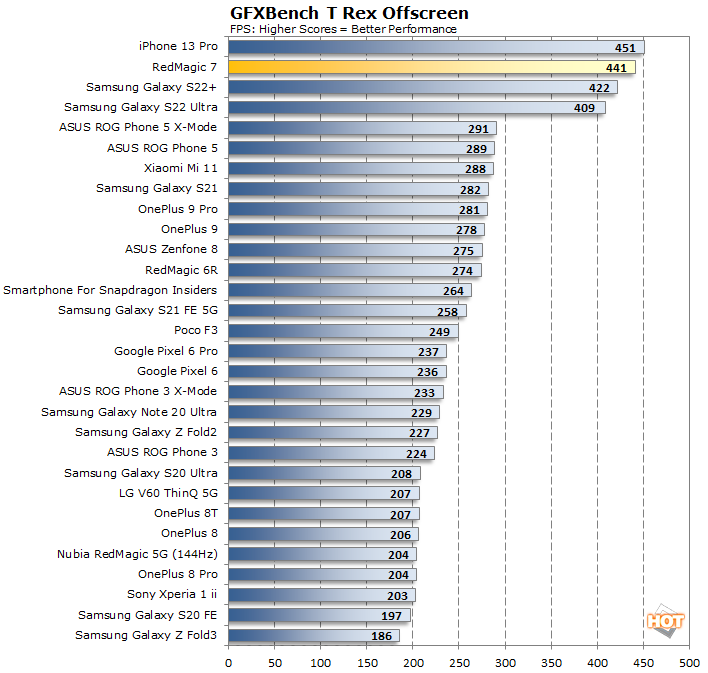
Now we're seeing the kind of performance
improvement we expected from the Snapdragon 8 Gen 1-equipped RedMagic 7.
This new phone clearly beats Snapdragon 888-powered devices, and comes
out way ahead of ASUS'
ROG Phone 5 in X-Mode. It even best Apple's latest iPhone 13 Pro
in the more modern Manhattan test, which is a major coup.
Futuremark's 3DMark Sling Shot is a newer benchmark module that's been added to the 3DMark mobile suite. Unlike previous gen 3DMark mobile tests, Sling Shot is a much more advanced OpenGL ES 3.1 and Metal API-based benchmark that employs more advanced rendering techniques, like volumetric lighting, particle illumination, multiple render targets, instanced rendering, uniform buffers and transform feedback.
Futuremark's 3DMark Sling Shot is a newer benchmark module that's been added to the 3DMark mobile suite. Unlike previous gen 3DMark mobile tests, Sling Shot is a much more advanced OpenGL ES 3.1 and Metal API-based benchmark that employs more advanced rendering techniques, like volumetric lighting, particle illumination, multiple render targets, instanced rendering, uniform buffers and transform feedback.

3DMark Sling Shot Extreme Benchmark
We're running this test in off-screen mode once again to remove display resolution differences from the equation. This lets us compare cross-platform results more reliably...
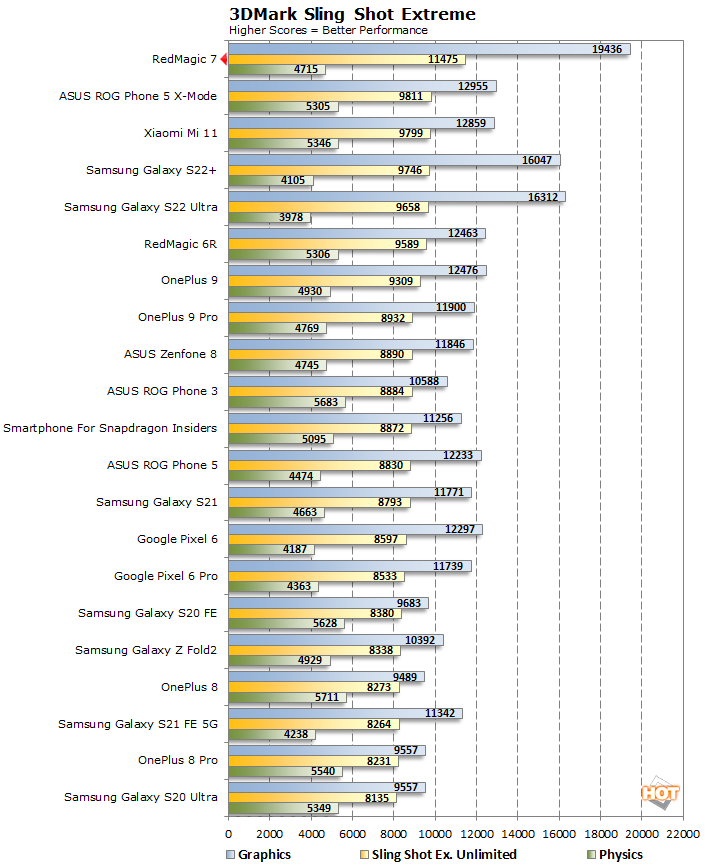
Here we see a massive improvement to the
overall score over Snapdragon 888-equipped flagships. The RedMagic 7
performs extremely well in this test, beating every other Android
flagship in the graphics score by a wide margin.
RedMagic 7 3DMark Wild Life Benchmark Tests
3DMark Wild Life is the latest
cross-platform test from UL. Its primary purpose is to measure GPU
performance across platforms, and two distinct tests are available.
The standard Wild Life test is designed to give feedback on how a
game performs over a short period of time. With mobile games, people
typically play in brief spurts when they find some free time; be it
on the bus, on the subway, or a quick battle royale session over
lunch break. The 3DMark Wild Life Stress Test, on the other hand,
shows how a device performs over a longer stretch of time, and takes
note of performance degradation that might crop up due to increased
heat levels and throttling.


3DMark Wild Life is a significantly more taxing graphics benchmark that employs cutting-edge mobile game engine technologies to deliver impressive visuals -- as you can see in the screen shot above. Here the Snapdragon 8 Gen 1-powered RedMagic 7 delivers a massive improvement in performance versus some of the fastest Snapdragon 888-equipped devices, and even comes within striking distance of the iPhone 13 Pro, which is running on its Metal API in this test.
Fortunately, the RedMagic 7 does not exhibit the throttling we experienced with the Galaxy S22 series in the Wild Life Stress test, managing a stability score of 96.9% at 165Hz with the fan enabled, and 92.8% at 120Hz with the fan disabled.
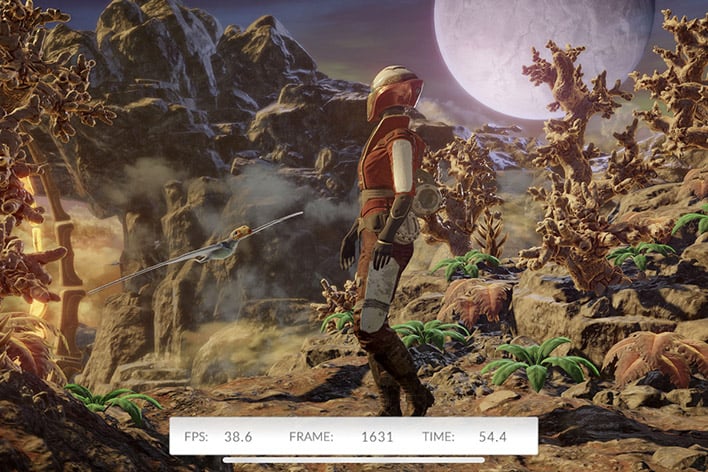
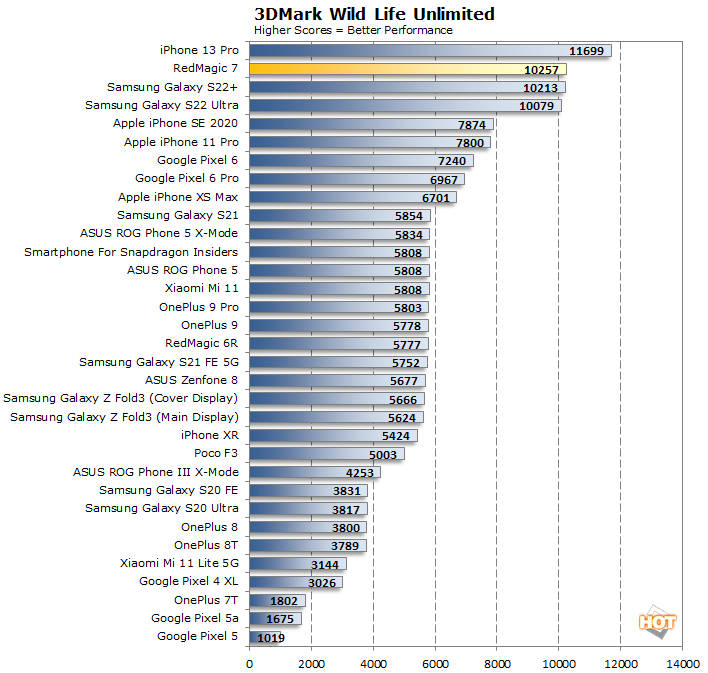
3DMark Wild Life is a significantly more taxing graphics benchmark that employs cutting-edge mobile game engine technologies to deliver impressive visuals -- as you can see in the screen shot above. Here the Snapdragon 8 Gen 1-powered RedMagic 7 delivers a massive improvement in performance versus some of the fastest Snapdragon 888-equipped devices, and even comes within striking distance of the iPhone 13 Pro, which is running on its Metal API in this test.
Fortunately, the RedMagic 7 does not exhibit the throttling we experienced with the Galaxy S22 series in the Wild Life Stress test, managing a stability score of 96.9% at 165Hz with the fan enabled, and 92.8% at 120Hz with the fan disabled.
RedMagic 7 Other Features and Battery Life
Battery life is a mixed bag. Strangely, the RedMagic 7’s 4500mAh
battery is smaller than its predecessor’s, despite both handsets being
almost identical in size. Our PCMark battery test lasted 9 hours and 1
minute at 120Hz, which isn’t terrible by any means, but not
spectacular – especially if you’re gaming. This phone supports 65W
wired fast charging (USB PD 3.0) and ships with a 65W brick, but
there’s no wireless charging.
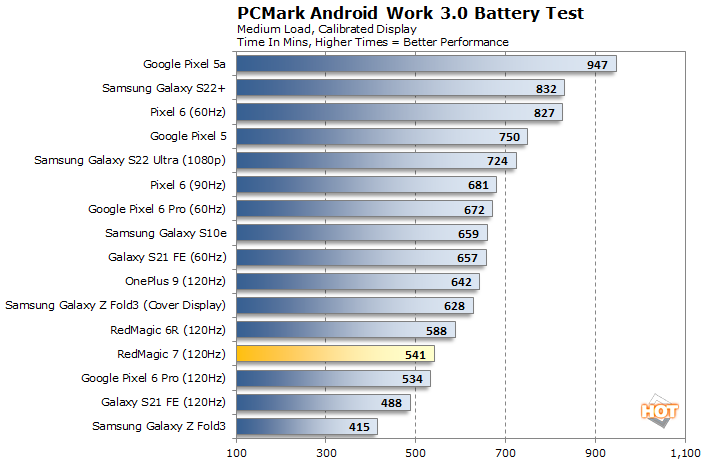
Other specs are pretty much what you’d expect in 2022. There’s WiFi 6E (802.11ax), Bluetooth 5.2 (LE), NFC, and dual-band A-GPS / Galileo / BDS / GLONASS positioning, plus the usual collection of sensors. The RedMagic 7 features an optical in-display fingerprint reader that’s fast and accurate, and doubles as a heart-rate sensor. Haptics feel sharp and precise but are probably a little weak for a gaming handset.
RedMagic 7 Software And User Experience
The RedMagic 7 runs RedMagic OS 5.0 on top of
Android 12, and this is where things get a little messy. While responsive
and lightweight, RedMagic’s software has always been fraught with awkward
translations, minor bugs, and a general lack of refinement. As such, it
doesn’t always deliver a pleasant user experience. But we’re seeing some
progress with this latest skin, which is visually more cohesive.
We also experienced less bugs this time around, so RedMagic appears to be paying attention. The settings menu is still disorganized, but the square icons are gone from the launcher. Also, bloatware is kept to a minimum, with the only pre-installed third-party app being NextWord Browser, which was easy to remove. Unfortunately, the company’s OS upgrade and security update policy still remains a mystery.
Game Space is where the RedMagic 7 really shines. Think of it as a separate landscape-mode launcher optimized for gaming, that’s activated with the red game mode switch. It’s extremely well thought out, and highly customizable. You can tweak everything from the 500Hz capacitive shoulder buttons to the refresh rate – and much more – on a per-game basis. Check out our RedMagic 5G review for a closer look.
RedMagic 7 Final Verdict
There’s a lot to like about the RedMagic 7, especially for $629. Not
only is it the most affordable Snapdragon 8 Gen 1 phone officially sold in
the US, it also delivers a gorgeous 165Hz display, US 5G support, great
audio features, and outstanding performance – especially when gaming.
Obviously, the design isn’t for everyone, but it’s on brand. The downsides
are the lackluster cameras, smallish battery, and less-refined software versus larger OEMs.
While the RedMagic 7 is purpose-built for gaming and not likely to replace a modern flagship in terms of all-around versatility, it’s absolutely the right device if you’re a hard-core mobile gamer, and it offers tremendous value in a quality package. Let’s hope that RedMagic continues to improve its software, and brings better shooters to the table next time around. You’ll be able to order the RedMagic 7 directly from the company’s website starting March 10.

|
|

